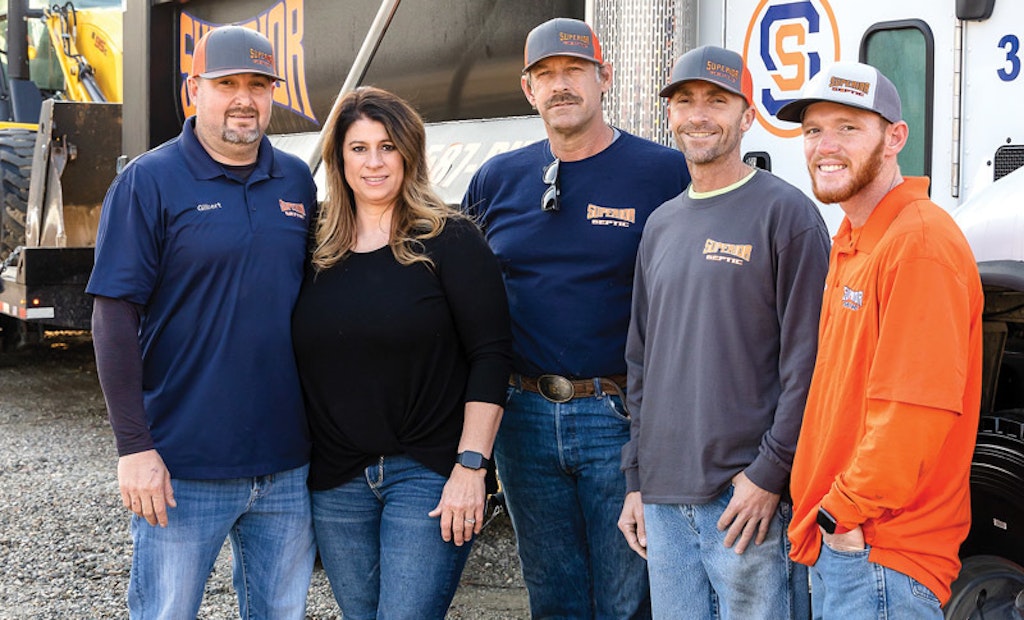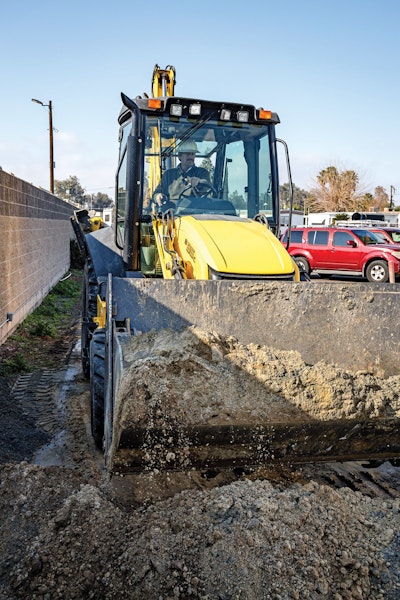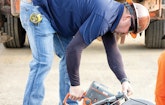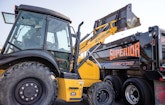
The Superior Septic crew includes, from left, Gilbert Herrera, Kari Herrera, Greg Shields, Josey Keeney and Caleb Morris. They are shown with the company’s 2020 Peterbilt 10-wheel dump truck with an Ox Bodies dump body.
The great Yankee catcher Yogi Berra supposedly said, “When you come to a fork in the road, take it.”
One could say Gilbert Herrera followed that advice. A plumber by training, and at a young age the owner of a plumbing business, he gradually worked his way into the onsite treatment sector and left his original profession behind.
The transition became official in January 2020 when he created Superior Septic Service in Bakersfield, California. He and his wife, Kari, and their three team members install, repair and pump septic systems throughout Kern County. They also make sewer connections for homeowners on Bakersfield’s fringes who are transitioning away from septic systems.
The Bakersfield area is growing, and jobs take the Superior Septic crews from “county islands” within the city, to the city’s developing fringes, and to the mountain foothills to the west.
IN THE FAMILY
Herrera got an early start in plumbing, working summers during high school for a new-construction plumbing business in San Diego. After high school he worked there full time for a spell, but found San Diego’s cost of living too high and so moved to Bakersfield, where his mother was living.
“I worked for a couple of plumbing outfits,” he says. “Then I got my contractor’s license when I was 23 and started doing service plumbing. It just got bigger and bigger.” When he met Kari, she owned Robo Plumbing, a company she had founded.
“Her family is all plumbers,” Herrera says. “She has three brothers who have their own companies. She has a sister who has her own company. So do her dad and four uncles. Her mother has a contractor’s license. When we got together in 2010, we combined our businesses. We stuck with the Robo Plumbing name because she’d been around a bit longer than I had.”
About 10 years ago, the company became more active in the onsite business, mainly with pumping and basic service. “In the last several years we really got into doing repairs and installs,” Herrera says. “We just got so big with the septic business that it was a little hard for Kari and me to handle both sides. So my stepson Cody Graves took over the plumbing part, and we branched off and started Superior Septic.”
Robo Plumbing has six plumbers and three service vans. Two-member crews do residential and commercial service plumbing, drain cleaning and sewer line replacements. The companies are based on the same property but have separate yards and offices; they share referrals. “Robo Plumbing still gets a lot of calls for septic services from past customers,” Herrera says. “They take the information and send it over to us.”
NATURAL TRANSITION
The move into the onsite sector happened naturally and gradually. “We started getting called out for plumbing by people who said their drains were backed up,” Herrera recalls. “We would get there and find out it was a septic backup. For a while we would sell the job, dig the tank up and then have another company come and pump the tank. We started getting so many that I built our first truck.” After a few years, he bought a second vacuum truck and started selling more repairs and tank replacements.
Davidson Enterprises built both pump trucks: a 2012 Freightliner with 2,000-gallon aluminum tank and National Vacuum 607 Pro 380 gpm pump; and a 2018 Hino with 2,000-gallon steel tank and National Vacuum 304 Challenger 210 cfm pump.
As he learned more about onsite systems, Herrera moved into complete system installations and replacements. It has been a profitable move, since California’s strict permitting requirements tend to discourage potential competitors.
Besides Herrera and his wife, who handles the office duties, the Superior Septic team includes helpers Caleb Morris and Hector Rodriguez, along with Greg Shields, a third-generation onsite installer who previously owned his family’s business. “He retired a couple of years ago, and after he got bored, he called me up and asked about a job,” Herrera says.
DIVERSE CONDITIONS
The company installs at least two new or replacement systems per week. A 2020 Peterbilt 10-wheel dump truck tows the company’s primary machine, a 2018 four-wheel-drive New Holland B95 backhoe with extend-a-hoe. For work in tight spaces, a 2018 Kubota M62 loader backhoe fits the bill. A 2019 Kubota tracked mini-excavator with a 12-inch bucket comes into play for trenching sewer lines. A 2017 Kubota BX23 mini-backhoe handles assorted small jobs.
On the outer fringes of the county, especially in the mountains, clay and rocky soil make installations challenging. “We’ve replaced a lot of teeth on backhoes doing jobs up there,” Herrera says.
Steep slopes can also be difficult: “We’ve done jobs where we had to put the tank on one side of the house and put the leach line on the other side at the bottom of the slope where it levels out. We find ways to get it in. We don’t do any mound systems.” On the other hand, in and around Bakersfield, “You can always hit sand, it just depends on what depth. There’s always sand down there; you just have to find it.”
Superior Septic installs only conventional systems, mostly using rock and pipe in the trenches. “If we have an issue with getting gravel into certain areas, then we use EZflow media (Infiltrator Water Technologies).” The drainfields consist of what California calls special trenches, 3 feet deep and 3 feet wide. In sandy soil, a drainfield for a home with a 1,000-gallon septic tank requires about 50 feet of special trench; heavy clay soils may require 190 feet or more.
TINY LOTS
Within Bakersfield there are a number of “county islands” — residential areas surrounded by the city but never annexed and not sewered. Many homes in those areas have front yards as small as 20 by 20 feet, leaving no room for a drainfield; they tend to be served by aging seepage pits that eventually fail.
“A lot of older houses have brick-lined seepage pits,” says Herrera. “They were dug out and handmade with bricks. They’re not very deep, and on many of them that we run into, the bricks have rotted out. We install a new seepage pit. We drill a 4- or 5-foot-diameter hole down 20 to 50 feet. We fill it partially with gravel, and the top of the pit has concrete liners that we stack up 10 feet high. Then we put a lid on it and connect the septic tank to it.”
Meanwhile, the outskirts of the city are developing on septic systems. “They’re building tract houses, running trunk lines in the streets and installing laterals up to the houses, but the sewer system there hasn’t reached the point of going live,” Herrera says.
Herrera and his team take pride in doing jobs right: “We’re not the cheapest in town, but we do the extras. We’re turnkey, so nobody has to do anything when we’re done except sit and watch the grass grow back. If we’re installing a system and something doesn’t look right, we’ll fix it.
“We work especially hard to clean up the yard when we’re done. We want the customers to be happy. A lot of our jobs are at existing houses where the systems have failed. We have to tear the yard up pretty good, but before we leave, we make sure it’s level and compacted so it won’t settle too much. We tell the customer that if it settles, or if we leave it high and it doesn’t settle, call us back and we’ll come out and fix it.”
MORE THAN PUMPING
Superior Septic maintains a focus on solving problems. Herrera observes, “A lot of our calls are, ‘My tank has been pumped three times in the last six months; I’ve got to find out what’s going on.’ If there is a problem, we need to find out what it is.
“We always verify if somebody has a seepage pit or a leach line, because if something is backing up, they’ve got a seepage pit, and they’re not pumping it, it’s going to back up again. We find out what kind of system they have. If it’s backing up, why? Is it saturated? Does it have a sludge buildup? I don’t like people calling back six months later and saying, ‘Hey, my tank backed up already.’ I let them know the first time I visit: You’ve got a problem and you need to fix it or it’s going to keep backing up.”
To help restore plugged drainfields, Superior Septic often relies on acid treatment. “We use 95% sulfuric acid; we keep four 5-gallon jugs on each truck,” Herrera says. “Typically, we do a 10-gallon treatment. After we pump the tank, we stick a hose and a funnel down the outlet side of the tank into the leachfield and just pour it down. It works 80% to 90% of the time. The acid kills the organic matter. It will burn away any sludge or solids that got through the tank and into the leach line. When we pour it down there, it gets everything draining again.”
Right now, both the installing and pumping sides of the business are humming along; the company does the bare minimum of advertising because the crews are maxed out. It certainly appears that Gilbert Herrera took the right fork in the road.
Getting the permits
Permitting for onsite treatment systems in California is more challenging than in most states. Under rules set by the California State Water Resources Control Board and administered by the Kern County Environmental Health Department, even residential systems and drainfield replacements require soil testing and a site plan done by a civil engineer.
“The engineer will test the soil and then send a report telling us where the leach lines need to go, what kind of soil it is, and how many feet of lines to put in,” says Gilbert Herrera of Superior Septic Services. “We send that to Environmental Health with a permit application, and then we get our permit and do our installation. They’re very particular about staying at certain distances from canals, public water mains, all sorts of easements.”
For the past eight years, Superior Septic has worked with civil engineer Karl Schwartz with The Dirt Guys geotechnical engineering firm. “We tell him how deep the outlet line of the septic tank is,” Herrera says. “He estimates where the bottom of the leachfield trenches will be and drills an 8-inch hole with a hand auger.
“He drills it 12 feet deeper than the trench bottom to make sure there is no groundwater. Then he drills two more test holes to the level of the trench bottom and does a percolation test.” He pre-saturates the holes for about an hour and then calculates the perc rate with help from a computer software program.









